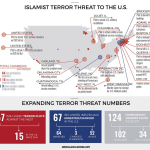What can you do?
- Take the class to be a poll worker
- Call your State Secretary, ask hard questions, get documentation, never believe the first answer.
- Investigate machines in your district or state, irregularities should be reported to the State Attorney General.
Voting machine study finds problems – but not ones easily fixed
Across the country, aging computerized voting machines nearing end of useful life
43 states set to use machines that will be at least 10 years old
Estimated cost to upgrade voting machines at $1 billion
Finding that many of the nation’s voting machines are “perilously close” to the end of their useful life, a study of voting systems in all 50 states recommended a series of steps that could be undertaken before voters cast their ballots in coming years.
Estimating it as a $1 billion problem, the experts from the Brennan Center for Justice at New York University School of Law said it likely was too late to replace equipment in most places before the 2016 election – although local officials should be preparing emergency paper ballots and taking other steps to minimize problems caused by failing machines.
Officials should already be looking ahead to 2020.
“One of the things that was really shocking to me is how far reaching it has become, and how few places have taken steps to replace their equipment,” said Lawrence Norden, deputy director of the Brennan Center’s Democracy Program.
The center is a nonpartisan law and policy think tank and advocacy organization that “seeks to improve our systems of democracy and justice.”
The report – “America’s Voting Machines at Risk” – was based on a wide-ranging review of the nation’s election systems. It included interviews with more than 30 state and 80 local election officials across the country.
While some voting-machine problems have been written about locally, others had not, reflecting the reality that even national elections are handled on the local level.
In fact, broad problems in voting systems can go unnoticed for years – until there is a tight election.
But many argued that unless and until equipment is replaced, we will increasingly see problems . . . flipped votes, freezes, shut downs, long lines, and, in the worst case scenarios, lost votes and erroneous tallies.
Brennan Center for Justice study ‘America’s Voting Machines at Risk’
Consider Florida and the presidential election of 2000, where the state’s hanging chads, high voter error rates and lost votes became central to the outcome and recounts that gripped the nation and put George W. Bush in the White House.
“Everything is at the local level,” Norden said. “So unless you have a Florida 2000 situation, you’re not getting national coverage of these individual problems, even if they’re becoming fairly common.
“In some ways, that’s the lesson of 2000,” he added. “There were plenty of warnings about punch-card machines before 2000, but they were reported locally. There were warnings from experts, but nobody was listening.”
As it stands, several battleground states have aging equipment.
According to Norden, 90 percent of counties in Ohio are using machines that will be at least 10 years old in November 2016. In Pennsylvania, North Carolina, Virginia and Florida, about half or more of counties have machines that will be 10 or more years old by November 2016.
The Brennan Center’s state numbers assume that equipment currently in use will not be replaced by 2016, although a very small number of counties or local jurisdictions could upgrade between the time they were surveyed and the elections.
EDITORS: BEGIN OPTIONAL TRIM
One example of the kind of problem cited in the study: Until an upgrade last year, the voting system in Leon County, Fla., was more than 20 years old and still needed to use an old-fashioned – and slow – analog modem to transmit information. When he needed to replace those modems, voting systems manager Mark Earley turned to eBay.
“They were even hard to find on eBay,” Earley said in an interview with McClatchy. “The system was a great system, for as long as it lasted. But as that modem issued showed, it was nearing the end of its life.”
Although Leon County, which includes the state capital of Tallahassee, upgraded in time for the 2014 election, several other counties in the state are still on the same system Leon County previously used, Earley said.
EDITORS: END OPTIONAL TRIM
The central problem is that unlike voting machines of previous eras, systems in place today were not designed to last for decades.
EDITORS: BEGIN OPTIONAL TRIM
“No one expects a laptop to last for 10 years,” the report noted. And yet many of the voting machines today that are entering their teen years have not been properly maintained – perhaps being stored in moist conditions – or rely on outdated software.
EDITORS: END OPTIONAL TRIM
According to the center, experts agree that the expected lifespan for core components of most voting machines purchased since 2000 is between 10 and 15 years.
In all, 43 states are using some machines that will be at least 10 years old in 2016. In 14 states, machines will be 15 or more years old.
EDITORS: STORY CAN END HERE
And while officials in 31 states said they wanted to purchase new voting machines in the next five years, officials from 22 of those states said they did not know where they would get money to do so, the report said.
That said, systemic problems and aging machines don’t necessarily make for an immediate calamity.
“No one we talked to predicted there will be a vast meltdown of all, or even most, of the nation’s voting equipment in 2016,” it concluded. “Aging machines do not all fail at once on a single day.”

 Muqtedar Khan
Muqtedar Khan



